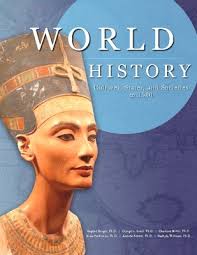
World History
The comprehensive contents from this book, combined with Odigia’s Teaching and Learning Tools have everything you need to engage, collaborate, track and assess your students.
This course includes:

practice questions
Helping Teachers Do What They Do Best: Teach

Customize
Use our courses as is or easily customize them to fit your teaching style and the needs of your students. You can add your favorite resources, hide and show our existing content and pre-built assessments, or make them your own. Everything your students need, in one place!

Engage and Collaborate
Odigia combines learning materials, discussions, and tools to create a familiar social experience for students allowing you to easily connect and redirect students attention.

Track
See how much time students are spending on different areas of the course, which areas are creating the most amount of engagement and identify topics the students are struggling with. Flag and provide feedback on assignments to proactively meet individual students' needs.

Assess
Game theory allows students to monitor their progress visually and motivates them to stay on track. Students can see exactly what activities they need to complete, which ones have been flagged and compare their progress against the overall class.
World History Outline
Prehistory
Early Middle Eastern and Northeast African Civilizations
Ancient and Early Medieval India
China and East Asia to the Ming Dynasty
The Greek World from the Bronze Age to the Roman Conquest
The Roman World from 735 BCE to 500 CE
Western Europe and Byzantium Circa 500 – 100CE
Islam to the Mamluks
African History to 1500
The Americas
Central Asia
Western Europe and Byzantium Circa 100 – 1500 CE
About the book
World History: Cultures, States, and Societies to 1500

World History: Cultures, States, and Societies to 1500 offers a comprehensive introduction to the history of humankind from prehistory to 1500. Authored by six USG faculty members with advance degrees in History, this textbook offers up-to-date original scholarship.
It covers such cultures, states, and societies as Ancient Mesopotamia, Ancient Israel, Dynastic Egypt, India’s Classical Age, the Dynasties of China, Archaic Greece, the Roman Empire, Islam, Medieval Africa, the Americas, and the Khanates of Central Asia. It includes 350 high-quality images and maps, chronologies, and learning questions to help guide student learning. Its digital nature allows students to follow links to applicable sources and videos, expanding their educational experience beyond the textbook.
About the authors:
Senior Contributing Authors
Euguene Berger, Georgia Gwinnett College
George Israel, Middle Georgia State University
Charlotte Miller, Middle Georgia State University
Brian Parkinson, Georgia Southwestern State University
Andrew Reeves, Middle Georgia State University
Nadejda Williams, University of West Georgia
